Marketing across Cultures Assignment CW1.
VerifiedAdded on 2023/01/18
|8
|2089
|48
AI Summary
I NEED CW1 EARLIER
NEED CW1 1500 SEPARATELY,WITH SEPARATE TABLE OF CONTENT AND REFERENCES
I NEED CW2 3000 WORDS
SEPARATELY,WITH SEPARATE TABLE OF CONTENT AND REFERENCES
Contribute Materials
Your contribution can guide someone’s learning journey. Share your
documents today.
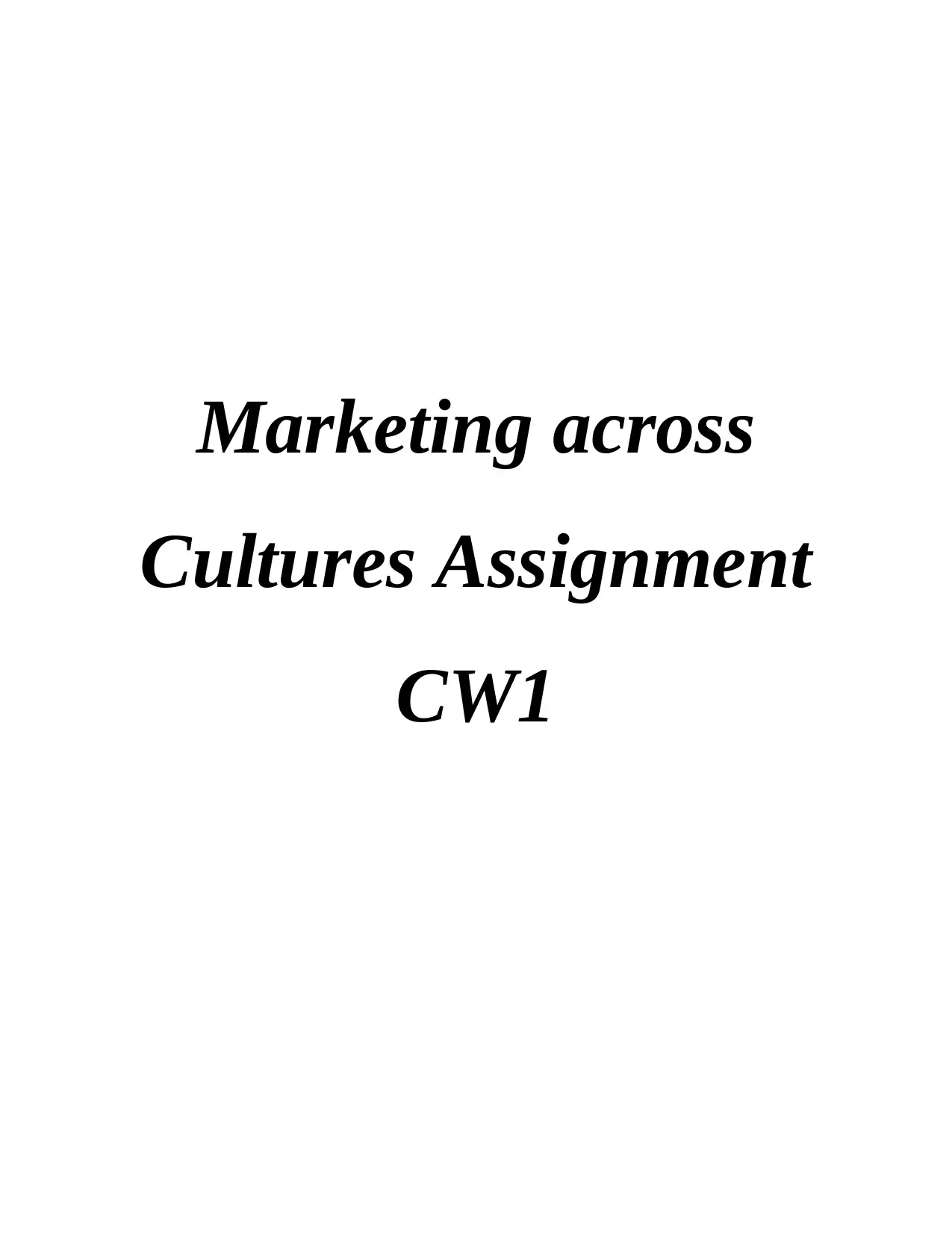
Marketing across
Cultures Assignment
CW1
Cultures Assignment
CW1
Secure Best Marks with AI Grader
Need help grading? Try our AI Grader for instant feedback on your assignments.
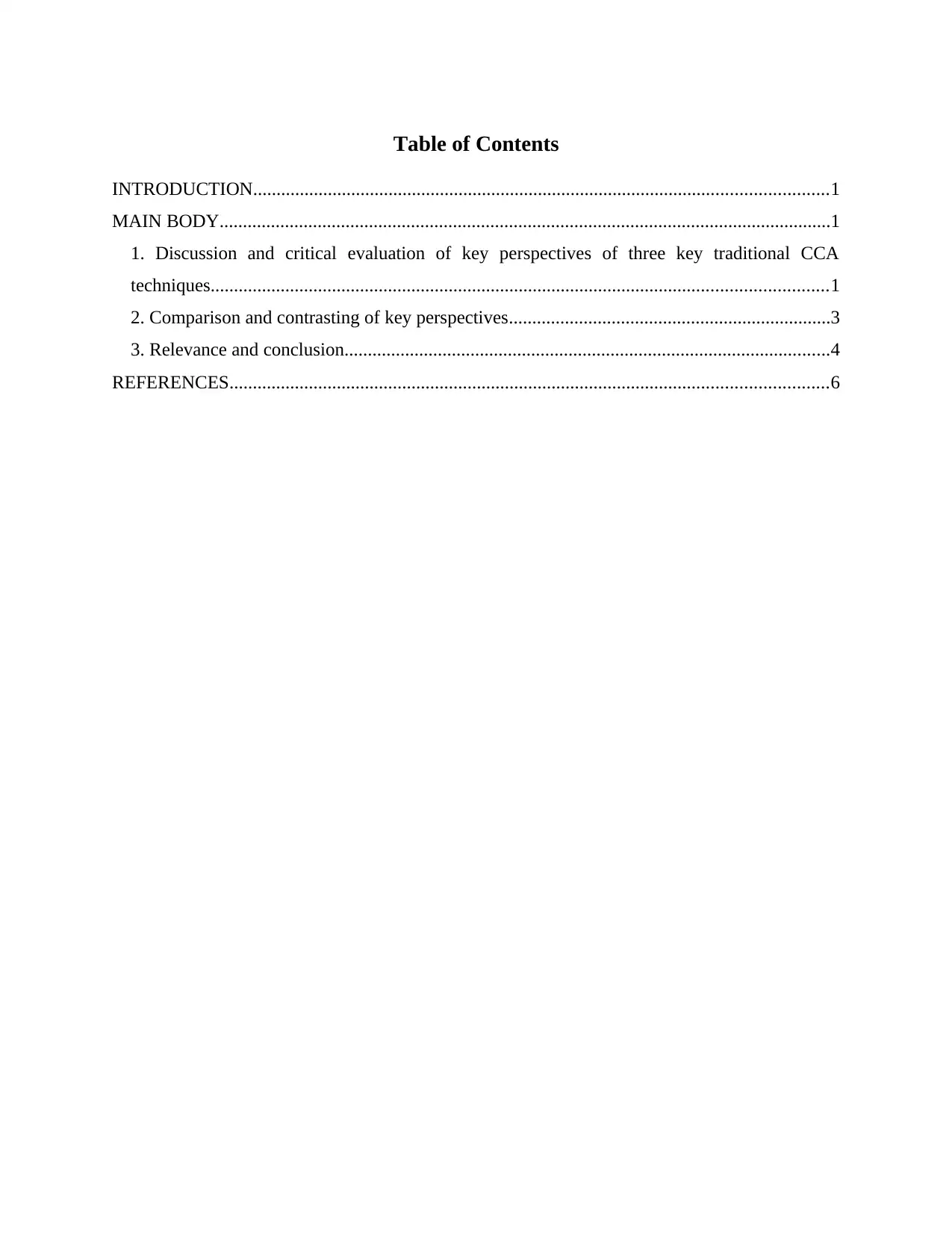
Table of Contents
INTRODUCTION...........................................................................................................................1
MAIN BODY...................................................................................................................................1
1. Discussion and critical evaluation of key perspectives of three key traditional CCA
techniques....................................................................................................................................1
2. Comparison and contrasting of key perspectives.....................................................................3
3. Relevance and conclusion........................................................................................................4
REFERENCES................................................................................................................................6
INTRODUCTION...........................................................................................................................1
MAIN BODY...................................................................................................................................1
1. Discussion and critical evaluation of key perspectives of three key traditional CCA
techniques....................................................................................................................................1
2. Comparison and contrasting of key perspectives.....................................................................3
3. Relevance and conclusion........................................................................................................4
REFERENCES................................................................................................................................6
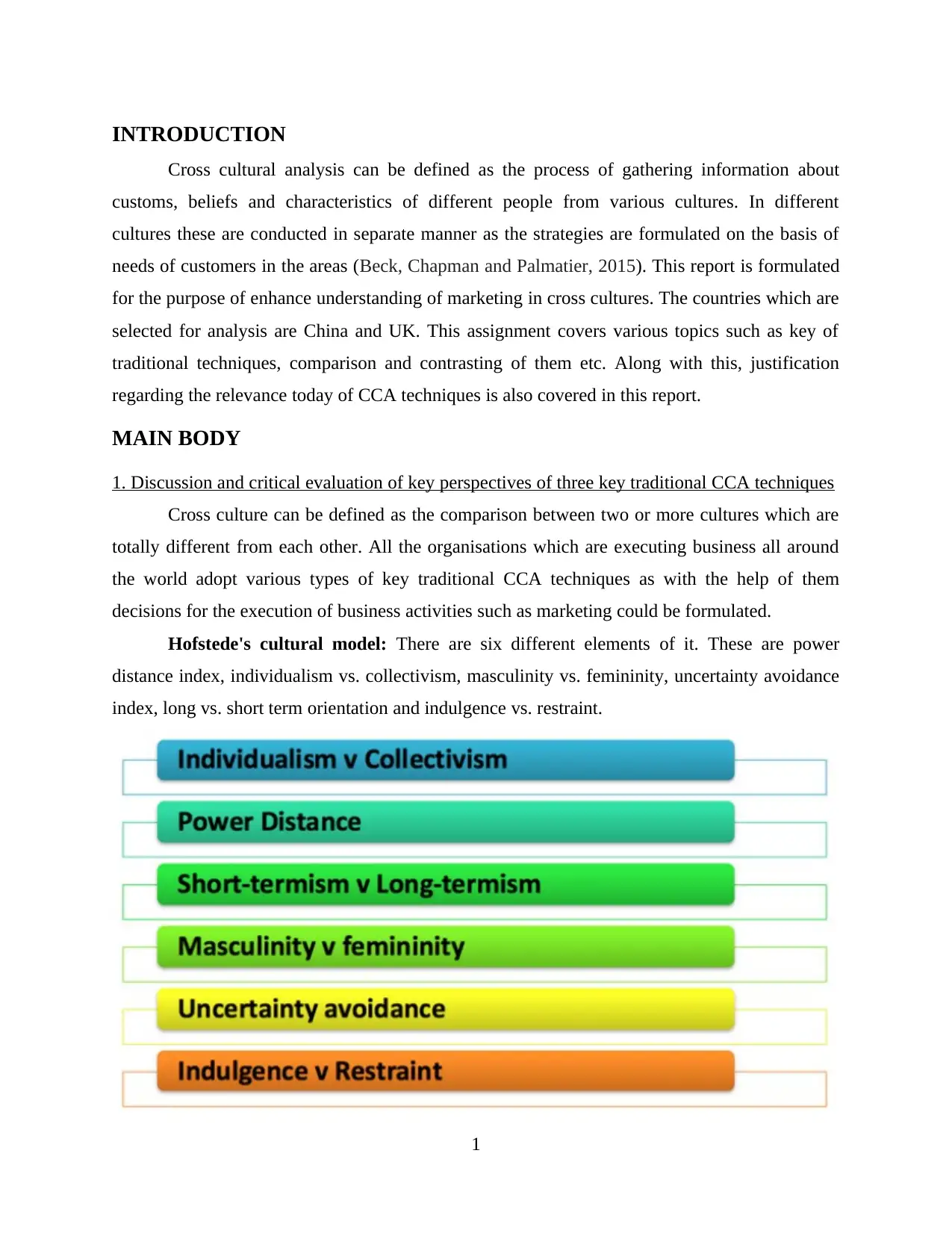
INTRODUCTION
Cross cultural analysis can be defined as the process of gathering information about
customs, beliefs and characteristics of different people from various cultures. In different
cultures these are conducted in separate manner as the strategies are formulated on the basis of
needs of customers in the areas (Beck, Chapman and Palmatier, 2015). This report is formulated
for the purpose of enhance understanding of marketing in cross cultures. The countries which are
selected for analysis are China and UK. This assignment covers various topics such as key of
traditional techniques, comparison and contrasting of them etc. Along with this, justification
regarding the relevance today of CCA techniques is also covered in this report.
MAIN BODY
1. Discussion and critical evaluation of key perspectives of three key traditional CCA techniques
Cross culture can be defined as the comparison between two or more cultures which are
totally different from each other. All the organisations which are executing business all around
the world adopt various types of key traditional CCA techniques as with the help of them
decisions for the execution of business activities such as marketing could be formulated.
Hofstede's cultural model: There are six different elements of it. These are power
distance index, individualism vs. collectivism, masculinity vs. femininity, uncertainty avoidance
index, long vs. short term orientation and indulgence vs. restraint.
1
Cross cultural analysis can be defined as the process of gathering information about
customs, beliefs and characteristics of different people from various cultures. In different
cultures these are conducted in separate manner as the strategies are formulated on the basis of
needs of customers in the areas (Beck, Chapman and Palmatier, 2015). This report is formulated
for the purpose of enhance understanding of marketing in cross cultures. The countries which are
selected for analysis are China and UK. This assignment covers various topics such as key of
traditional techniques, comparison and contrasting of them etc. Along with this, justification
regarding the relevance today of CCA techniques is also covered in this report.
MAIN BODY
1. Discussion and critical evaluation of key perspectives of three key traditional CCA techniques
Cross culture can be defined as the comparison between two or more cultures which are
totally different from each other. All the organisations which are executing business all around
the world adopt various types of key traditional CCA techniques as with the help of them
decisions for the execution of business activities such as marketing could be formulated.
Hofstede's cultural model: There are six different elements of it. These are power
distance index, individualism vs. collectivism, masculinity vs. femininity, uncertainty avoidance
index, long vs. short term orientation and indulgence vs. restraint.
1
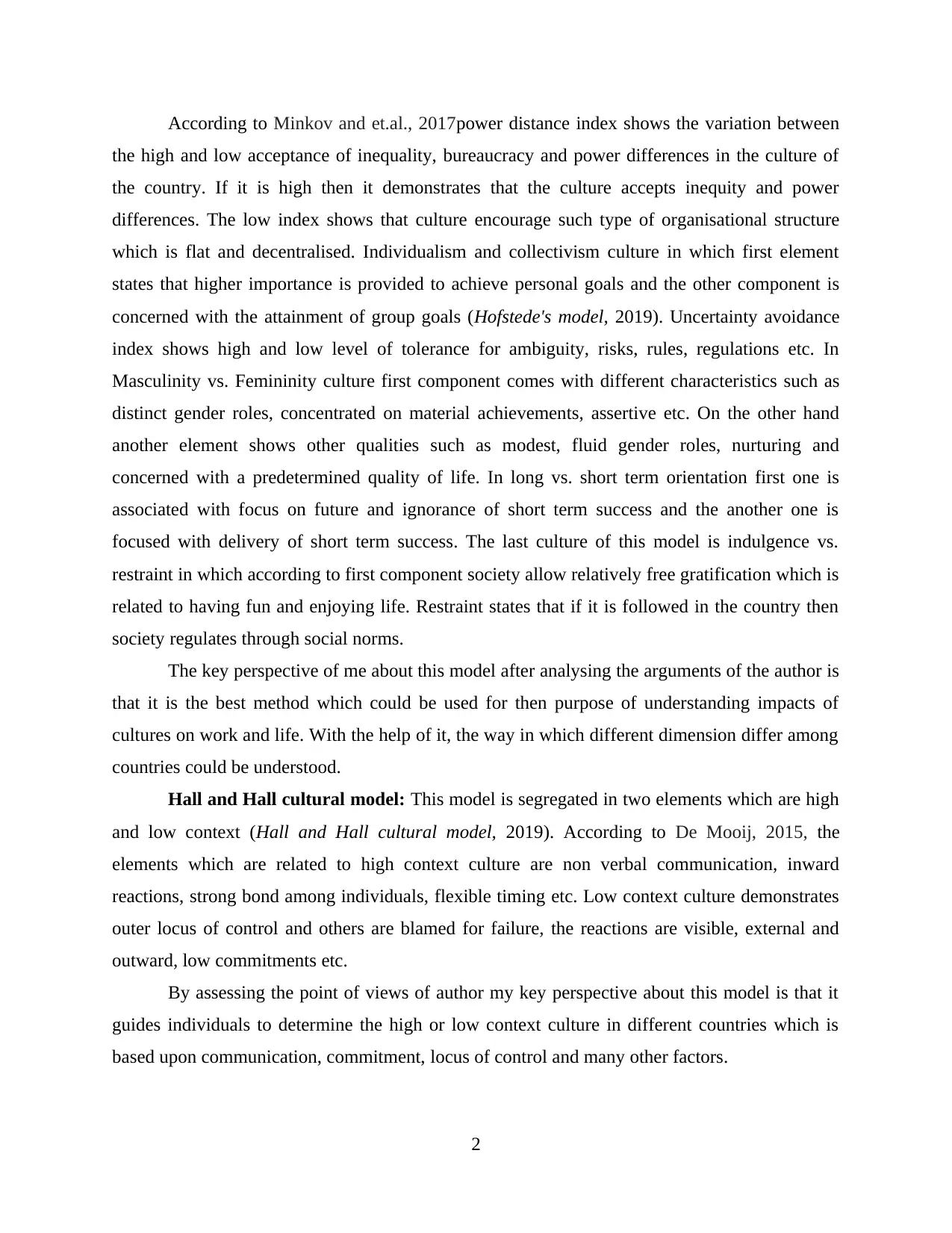
According to Minkov and et.al., 2017power distance index shows the variation between
the high and low acceptance of inequality, bureaucracy and power differences in the culture of
the country. If it is high then it demonstrates that the culture accepts inequity and power
differences. The low index shows that culture encourage such type of organisational structure
which is flat and decentralised. Individualism and collectivism culture in which first element
states that higher importance is provided to achieve personal goals and the other component is
concerned with the attainment of group goals (Hofstede's model, 2019). Uncertainty avoidance
index shows high and low level of tolerance for ambiguity, risks, rules, regulations etc. In
Masculinity vs. Femininity culture first component comes with different characteristics such as
distinct gender roles, concentrated on material achievements, assertive etc. On the other hand
another element shows other qualities such as modest, fluid gender roles, nurturing and
concerned with a predetermined quality of life. In long vs. short term orientation first one is
associated with focus on future and ignorance of short term success and the another one is
focused with delivery of short term success. The last culture of this model is indulgence vs.
restraint in which according to first component society allow relatively free gratification which is
related to having fun and enjoying life. Restraint states that if it is followed in the country then
society regulates through social norms.
The key perspective of me about this model after analysing the arguments of the author is
that it is the best method which could be used for then purpose of understanding impacts of
cultures on work and life. With the help of it, the way in which different dimension differ among
countries could be understood.
Hall and Hall cultural model: This model is segregated in two elements which are high
and low context (Hall and Hall cultural model, 2019). According to De Mooij, 2015, the
elements which are related to high context culture are non verbal communication, inward
reactions, strong bond among individuals, flexible timing etc. Low context culture demonstrates
outer locus of control and others are blamed for failure, the reactions are visible, external and
outward, low commitments etc.
By assessing the point of views of author my key perspective about this model is that it
guides individuals to determine the high or low context culture in different countries which is
based upon communication, commitment, locus of control and many other factors.
2
the high and low acceptance of inequality, bureaucracy and power differences in the culture of
the country. If it is high then it demonstrates that the culture accepts inequity and power
differences. The low index shows that culture encourage such type of organisational structure
which is flat and decentralised. Individualism and collectivism culture in which first element
states that higher importance is provided to achieve personal goals and the other component is
concerned with the attainment of group goals (Hofstede's model, 2019). Uncertainty avoidance
index shows high and low level of tolerance for ambiguity, risks, rules, regulations etc. In
Masculinity vs. Femininity culture first component comes with different characteristics such as
distinct gender roles, concentrated on material achievements, assertive etc. On the other hand
another element shows other qualities such as modest, fluid gender roles, nurturing and
concerned with a predetermined quality of life. In long vs. short term orientation first one is
associated with focus on future and ignorance of short term success and the another one is
focused with delivery of short term success. The last culture of this model is indulgence vs.
restraint in which according to first component society allow relatively free gratification which is
related to having fun and enjoying life. Restraint states that if it is followed in the country then
society regulates through social norms.
The key perspective of me about this model after analysing the arguments of the author is
that it is the best method which could be used for then purpose of understanding impacts of
cultures on work and life. With the help of it, the way in which different dimension differ among
countries could be understood.
Hall and Hall cultural model: This model is segregated in two elements which are high
and low context (Hall and Hall cultural model, 2019). According to De Mooij, 2015, the
elements which are related to high context culture are non verbal communication, inward
reactions, strong bond among individuals, flexible timing etc. Low context culture demonstrates
outer locus of control and others are blamed for failure, the reactions are visible, external and
outward, low commitments etc.
By assessing the point of views of author my key perspective about this model is that it
guides individuals to determine the high or low context culture in different countries which is
based upon communication, commitment, locus of control and many other factors.
2
Secure Best Marks with AI Grader
Need help grading? Try our AI Grader for instant feedback on your assignments.
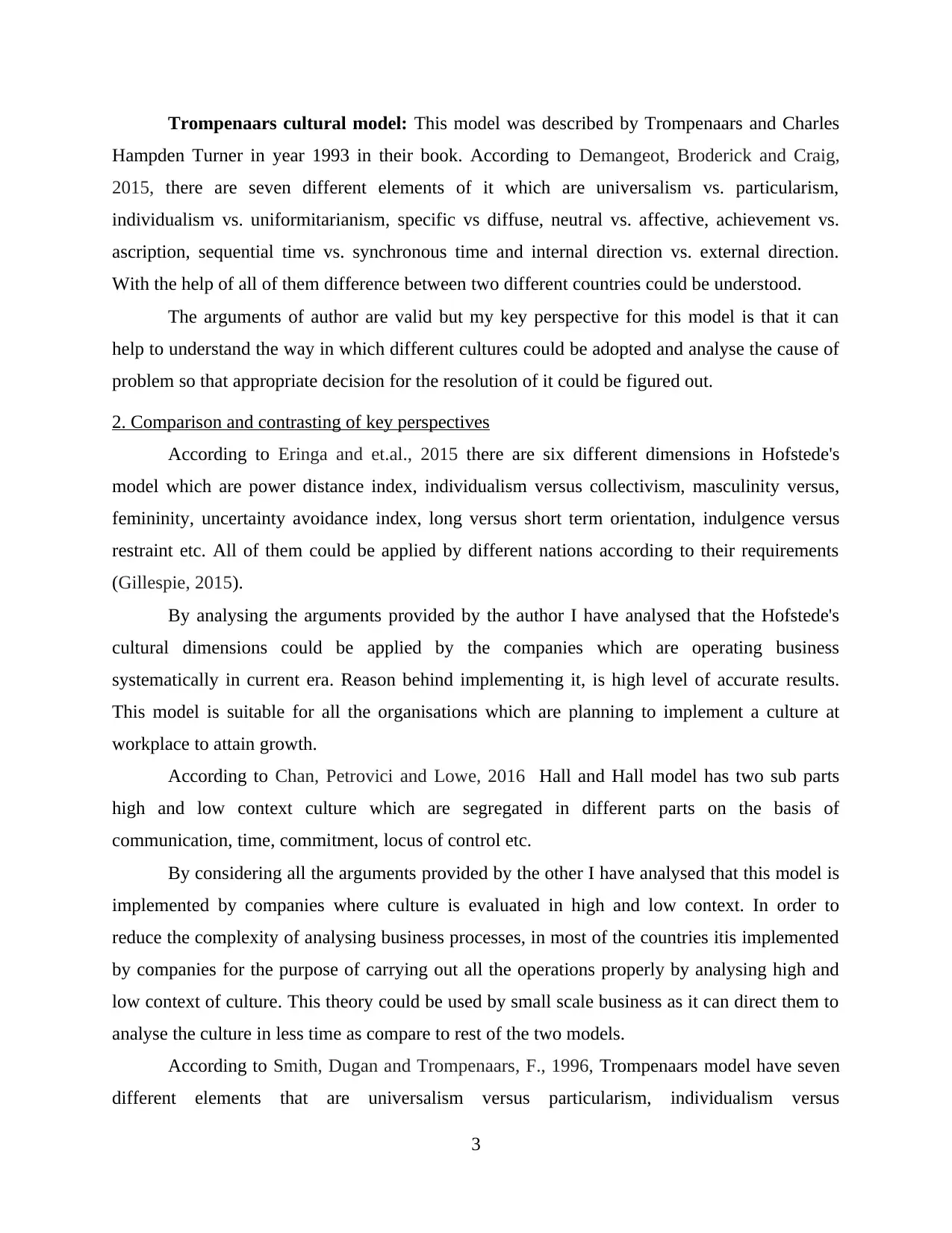
Trompenaars cultural model: This model was described by Trompenaars and Charles
Hampden Turner in year 1993 in their book. According to Demangeot, Broderick and Craig,
2015, there are seven different elements of it which are universalism vs. particularism,
individualism vs. uniformitarianism, specific vs diffuse, neutral vs. affective, achievement vs.
ascription, sequential time vs. synchronous time and internal direction vs. external direction.
With the help of all of them difference between two different countries could be understood.
The arguments of author are valid but my key perspective for this model is that it can
help to understand the way in which different cultures could be adopted and analyse the cause of
problem so that appropriate decision for the resolution of it could be figured out.
2. Comparison and contrasting of key perspectives
According to Eringa and et.al., 2015 there are six different dimensions in Hofstede's
model which are power distance index, individualism versus collectivism, masculinity versus,
femininity, uncertainty avoidance index, long versus short term orientation, indulgence versus
restraint etc. All of them could be applied by different nations according to their requirements
(Gillespie, 2015).
By analysing the arguments provided by the author I have analysed that the Hofstede's
cultural dimensions could be applied by the companies which are operating business
systematically in current era. Reason behind implementing it, is high level of accurate results.
This model is suitable for all the organisations which are planning to implement a culture at
workplace to attain growth.
According to Chan, Petrovici and Lowe, 2016 Hall and Hall model has two sub parts
high and low context culture which are segregated in different parts on the basis of
communication, time, commitment, locus of control etc.
By considering all the arguments provided by the other I have analysed that this model is
implemented by companies where culture is evaluated in high and low context. In order to
reduce the complexity of analysing business processes, in most of the countries itis implemented
by companies for the purpose of carrying out all the operations properly by analysing high and
low context of culture. This theory could be used by small scale business as it can direct them to
analyse the culture in less time as compare to rest of the two models.
According to Smith, Dugan and Trompenaars, F., 1996, Trompenaars model have seven
different elements that are universalism versus particularism, individualism versus
3
Hampden Turner in year 1993 in their book. According to Demangeot, Broderick and Craig,
2015, there are seven different elements of it which are universalism vs. particularism,
individualism vs. uniformitarianism, specific vs diffuse, neutral vs. affective, achievement vs.
ascription, sequential time vs. synchronous time and internal direction vs. external direction.
With the help of all of them difference between two different countries could be understood.
The arguments of author are valid but my key perspective for this model is that it can
help to understand the way in which different cultures could be adopted and analyse the cause of
problem so that appropriate decision for the resolution of it could be figured out.
2. Comparison and contrasting of key perspectives
According to Eringa and et.al., 2015 there are six different dimensions in Hofstede's
model which are power distance index, individualism versus collectivism, masculinity versus,
femininity, uncertainty avoidance index, long versus short term orientation, indulgence versus
restraint etc. All of them could be applied by different nations according to their requirements
(Gillespie, 2015).
By analysing the arguments provided by the author I have analysed that the Hofstede's
cultural dimensions could be applied by the companies which are operating business
systematically in current era. Reason behind implementing it, is high level of accurate results.
This model is suitable for all the organisations which are planning to implement a culture at
workplace to attain growth.
According to Chan, Petrovici and Lowe, 2016 Hall and Hall model has two sub parts
high and low context culture which are segregated in different parts on the basis of
communication, time, commitment, locus of control etc.
By considering all the arguments provided by the other I have analysed that this model is
implemented by companies where culture is evaluated in high and low context. In order to
reduce the complexity of analysing business processes, in most of the countries itis implemented
by companies for the purpose of carrying out all the operations properly by analysing high and
low context of culture. This theory could be used by small scale business as it can direct them to
analyse the culture in less time as compare to rest of the two models.
According to Smith, Dugan and Trompenaars, F., 1996, Trompenaars model have seven
different elements that are universalism versus particularism, individualism versus
3
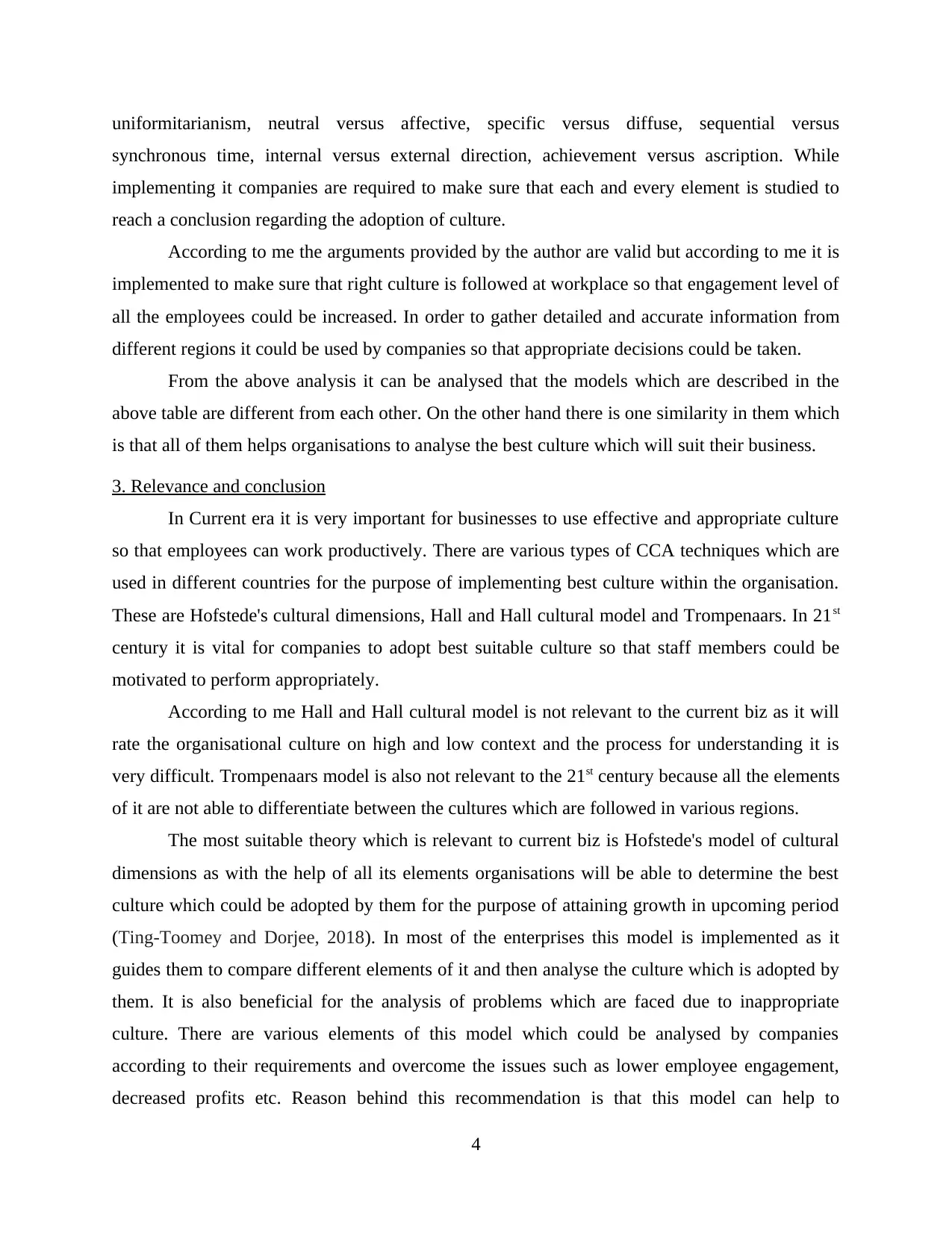
uniformitarianism, neutral versus affective, specific versus diffuse, sequential versus
synchronous time, internal versus external direction, achievement versus ascription. While
implementing it companies are required to make sure that each and every element is studied to
reach a conclusion regarding the adoption of culture.
According to me the arguments provided by the author are valid but according to me it is
implemented to make sure that right culture is followed at workplace so that engagement level of
all the employees could be increased. In order to gather detailed and accurate information from
different regions it could be used by companies so that appropriate decisions could be taken.
From the above analysis it can be analysed that the models which are described in the
above table are different from each other. On the other hand there is one similarity in them which
is that all of them helps organisations to analyse the best culture which will suit their business.
3. Relevance and conclusion
In Current era it is very important for businesses to use effective and appropriate culture
so that employees can work productively. There are various types of CCA techniques which are
used in different countries for the purpose of implementing best culture within the organisation.
These are Hofstede's cultural dimensions, Hall and Hall cultural model and Trompenaars. In 21st
century it is vital for companies to adopt best suitable culture so that staff members could be
motivated to perform appropriately.
According to me Hall and Hall cultural model is not relevant to the current biz as it will
rate the organisational culture on high and low context and the process for understanding it is
very difficult. Trompenaars model is also not relevant to the 21st century because all the elements
of it are not able to differentiate between the cultures which are followed in various regions.
The most suitable theory which is relevant to current biz is Hofstede's model of cultural
dimensions as with the help of all its elements organisations will be able to determine the best
culture which could be adopted by them for the purpose of attaining growth in upcoming period
(Ting-Toomey and Dorjee, 2018). In most of the enterprises this model is implemented as it
guides them to compare different elements of it and then analyse the culture which is adopted by
them. It is also beneficial for the analysis of problems which are faced due to inappropriate
culture. There are various elements of this model which could be analysed by companies
according to their requirements and overcome the issues such as lower employee engagement,
decreased profits etc. Reason behind this recommendation is that this model can help to
4
synchronous time, internal versus external direction, achievement versus ascription. While
implementing it companies are required to make sure that each and every element is studied to
reach a conclusion regarding the adoption of culture.
According to me the arguments provided by the author are valid but according to me it is
implemented to make sure that right culture is followed at workplace so that engagement level of
all the employees could be increased. In order to gather detailed and accurate information from
different regions it could be used by companies so that appropriate decisions could be taken.
From the above analysis it can be analysed that the models which are described in the
above table are different from each other. On the other hand there is one similarity in them which
is that all of them helps organisations to analyse the best culture which will suit their business.
3. Relevance and conclusion
In Current era it is very important for businesses to use effective and appropriate culture
so that employees can work productively. There are various types of CCA techniques which are
used in different countries for the purpose of implementing best culture within the organisation.
These are Hofstede's cultural dimensions, Hall and Hall cultural model and Trompenaars. In 21st
century it is vital for companies to adopt best suitable culture so that staff members could be
motivated to perform appropriately.
According to me Hall and Hall cultural model is not relevant to the current biz as it will
rate the organisational culture on high and low context and the process for understanding it is
very difficult. Trompenaars model is also not relevant to the 21st century because all the elements
of it are not able to differentiate between the cultures which are followed in various regions.
The most suitable theory which is relevant to current biz is Hofstede's model of cultural
dimensions as with the help of all its elements organisations will be able to determine the best
culture which could be adopted by them for the purpose of attaining growth in upcoming period
(Ting-Toomey and Dorjee, 2018). In most of the enterprises this model is implemented as it
guides them to compare different elements of it and then analyse the culture which is adopted by
them. It is also beneficial for the analysis of problems which are faced due to inappropriate
culture. There are various elements of this model which could be analysed by companies
according to their requirements and overcome the issues such as lower employee engagement,
decreased profits etc. Reason behind this recommendation is that this model can help to
4
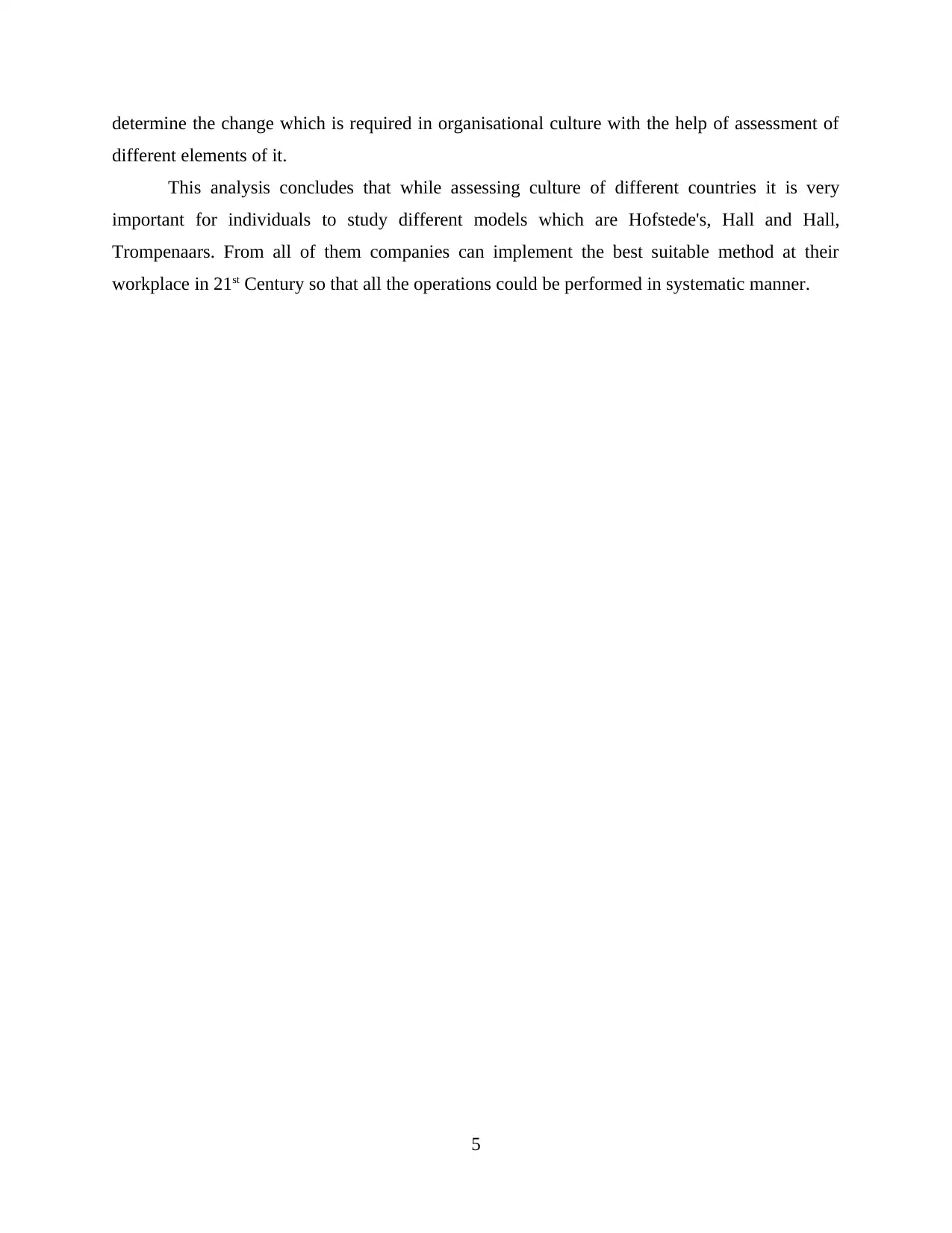
determine the change which is required in organisational culture with the help of assessment of
different elements of it.
This analysis concludes that while assessing culture of different countries it is very
important for individuals to study different models which are Hofstede's, Hall and Hall,
Trompenaars. From all of them companies can implement the best suitable method at their
workplace in 21st Century so that all the operations could be performed in systematic manner.
5
different elements of it.
This analysis concludes that while assessing culture of different countries it is very
important for individuals to study different models which are Hofstede's, Hall and Hall,
Trompenaars. From all of them companies can implement the best suitable method at their
workplace in 21st Century so that all the operations could be performed in systematic manner.
5
Paraphrase This Document
Need a fresh take? Get an instant paraphrase of this document with our AI Paraphraser
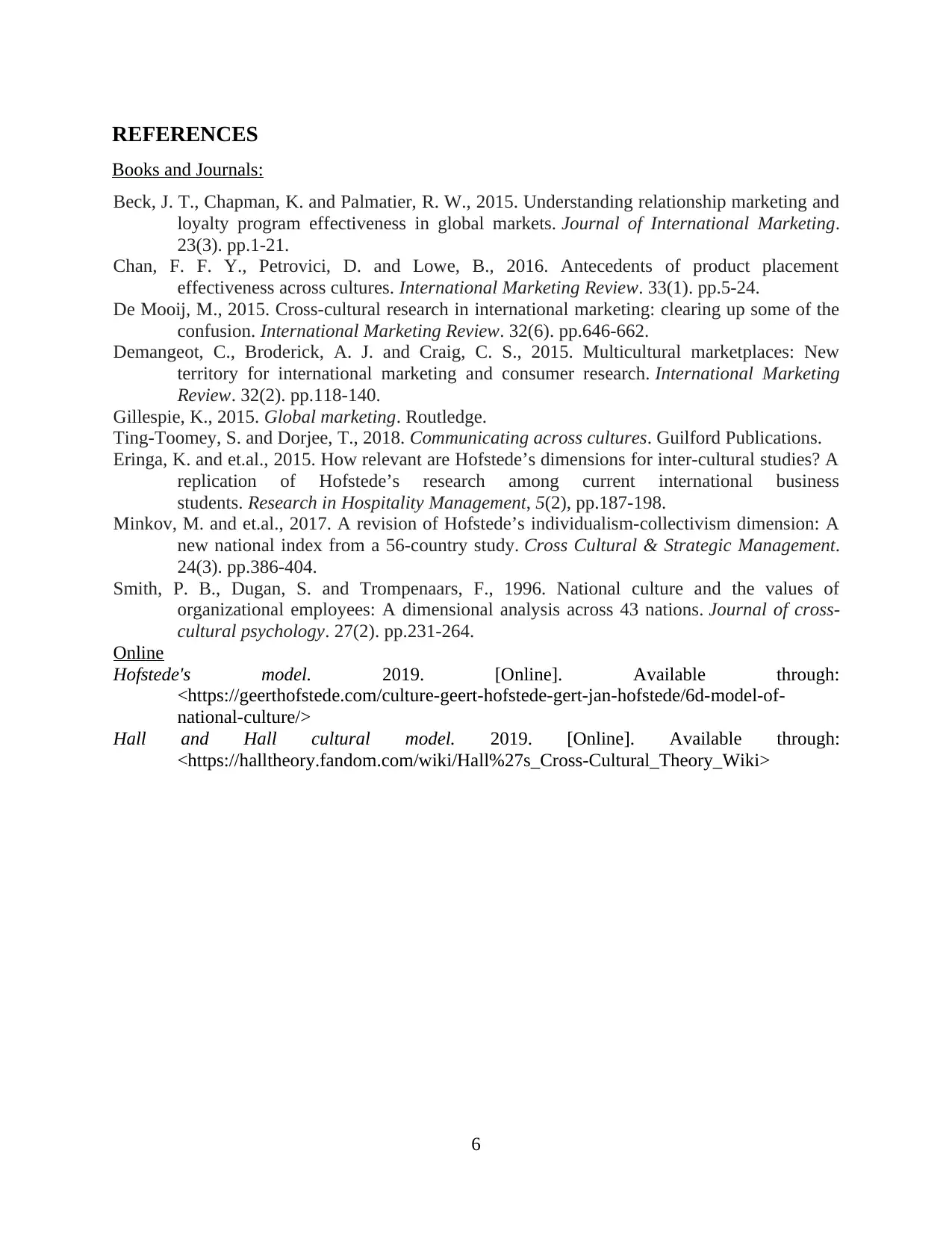
REFERENCES
Books and Journals:
Beck, J. T., Chapman, K. and Palmatier, R. W., 2015. Understanding relationship marketing and
loyalty program effectiveness in global markets. Journal of International Marketing.
23(3). pp.1-21.
Chan, F. F. Y., Petrovici, D. and Lowe, B., 2016. Antecedents of product placement
effectiveness across cultures. International Marketing Review. 33(1). pp.5-24.
De Mooij, M., 2015. Cross-cultural research in international marketing: clearing up some of the
confusion. International Marketing Review. 32(6). pp.646-662.
Demangeot, C., Broderick, A. J. and Craig, C. S., 2015. Multicultural marketplaces: New
territory for international marketing and consumer research. International Marketing
Review. 32(2). pp.118-140.
Gillespie, K., 2015. Global marketing. Routledge.
Ting-Toomey, S. and Dorjee, T., 2018. Communicating across cultures. Guilford Publications.
Eringa, K. and et.al., 2015. How relevant are Hofstede’s dimensions for inter-cultural studies? A
replication of Hofstede’s research among current international business
students. Research in Hospitality Management, 5(2), pp.187-198.
Minkov, M. and et.al., 2017. A revision of Hofstede’s individualism-collectivism dimension: A
new national index from a 56-country study. Cross Cultural & Strategic Management.
24(3). pp.386-404.
Smith, P. B., Dugan, S. and Trompenaars, F., 1996. National culture and the values of
organizational employees: A dimensional analysis across 43 nations. Journal of cross-
cultural psychology. 27(2). pp.231-264.
Online
Hofstede's model. 2019. [Online]. Available through:
<https://geerthofstede.com/culture-geert-hofstede-gert-jan-hofstede/6d-model-of-
national-culture/>
Hall and Hall cultural model. 2019. [Online]. Available through:
<https://halltheory.fandom.com/wiki/Hall%27s_Cross-Cultural_Theory_Wiki>
6
Books and Journals:
Beck, J. T., Chapman, K. and Palmatier, R. W., 2015. Understanding relationship marketing and
loyalty program effectiveness in global markets. Journal of International Marketing.
23(3). pp.1-21.
Chan, F. F. Y., Petrovici, D. and Lowe, B., 2016. Antecedents of product placement
effectiveness across cultures. International Marketing Review. 33(1). pp.5-24.
De Mooij, M., 2015. Cross-cultural research in international marketing: clearing up some of the
confusion. International Marketing Review. 32(6). pp.646-662.
Demangeot, C., Broderick, A. J. and Craig, C. S., 2015. Multicultural marketplaces: New
territory for international marketing and consumer research. International Marketing
Review. 32(2). pp.118-140.
Gillespie, K., 2015. Global marketing. Routledge.
Ting-Toomey, S. and Dorjee, T., 2018. Communicating across cultures. Guilford Publications.
Eringa, K. and et.al., 2015. How relevant are Hofstede’s dimensions for inter-cultural studies? A
replication of Hofstede’s research among current international business
students. Research in Hospitality Management, 5(2), pp.187-198.
Minkov, M. and et.al., 2017. A revision of Hofstede’s individualism-collectivism dimension: A
new national index from a 56-country study. Cross Cultural & Strategic Management.
24(3). pp.386-404.
Smith, P. B., Dugan, S. and Trompenaars, F., 1996. National culture and the values of
organizational employees: A dimensional analysis across 43 nations. Journal of cross-
cultural psychology. 27(2). pp.231-264.
Online
Hofstede's model. 2019. [Online]. Available through:
<https://geerthofstede.com/culture-geert-hofstede-gert-jan-hofstede/6d-model-of-
national-culture/>
Hall and Hall cultural model. 2019. [Online]. Available through:
<https://halltheory.fandom.com/wiki/Hall%27s_Cross-Cultural_Theory_Wiki>
6
1 out of 8
Related Documents
Your All-in-One AI-Powered Toolkit for Academic Success.
+13062052269
info@desklib.com
Available 24*7 on WhatsApp / Email
![[object Object]](/_next/static/media/star-bottom.7253800d.svg)
Unlock your academic potential
© 2024 | Zucol Services PVT LTD | All rights reserved.





